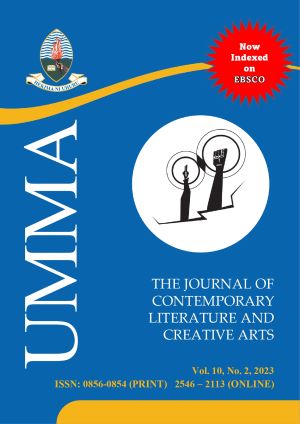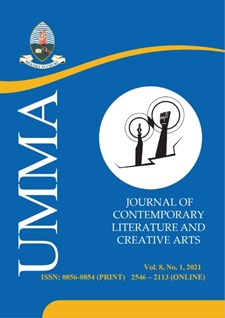Uhuru Torch Images in Sukuma Praise Songs
Abstract
This article examines Uhuru (Independence)Torch images in selected Sukuma praise songs, highlighting their significance and the images they embody. The analysis of these songs attempted to capture the Sukuma imagination of the Torch €”an independence symbol €”in terms of sociocultural, political and economic dimensions. The purposively selected Sukuma praise songs contain Uhuru Torch attributes reinforced through the evocation of praise tones. The Torch is the focal point of these songs since the praising they imbue significantly extrapolate its significance to the society. The qualitative study explored in-depth the Sukuma sociocultural, political and economic practices embedded in the images of these Sukuma praise songs to assess their significance in capturing the Uhuru essence and what it represents. It analyses the Uhuru Torch images in Sukuma praise songs from two angles: the angle of bodily/physical sensation (images of fire and smoke of Uhuru Torch) and the association/comparison perspective (Uhuru Torch in the image of man and the mythological images of the Torch). At the centre of analysis of selected Sukuma praise songs are images interpreted in partnership with Uhuru Torch observable in diverse artistic contexts and perceptions of the Sukuma lore. The study found that these images are primarily a product of the human mind, which is machinery for digesting images for consumption and awareness of the society.
Keywords:
Uhuru Torch, Sukuma Praise Songs, Uhuru Imagery
References
Abrahams, M. H. and Harpham, G. G., 2005, A Glossary of Literary Terms, Thomson Wadsworth, Boston MA.
Akivaga, K. & Odaga B., 1982, Oral literature: A School Certificate Course, Eastern African Educational Publishers, Nairobi.
Arnheim, R. 1969, Art and Visual Perception, Faber and Faber, London.
Berger, P. & Luckmann, T. 2002, The Social Construction of Reality (22nd ed.), F.S. Fernandes, Trans: Petropolis €”Vozes.
Crystal, D. 1987, The Cambridge Encyclopaedia of Language, Cambridge University Press, Cambridge
Culler, J. 1997, Literary Theory: A Very Short Introduction (First Edition), Oxford University Press, Oxford.
Grzybovski, D. et al. 2007, Theory of Imagery in Studies of the Change Process, BAR (Brazilian Administration Review), Passo Fundo, RS.
Guerin, W. 2005, A handbook of critical approaches to literature (5th Ed.), New York University Press, Oxford.
Edgar, R. 1989, Literature: An introduction to reading and writing, study guide, Prentice Hall, Englewood Cliffs NJ.
Elahel, F. 2010, Symbols, metaphors and similes in literature: a case study of Animal Farm, Islamic Azad University of Bandar Abbas, Iran.
Harliani, I. 2014, An Analysis of the Power of Imagery in Suzzanne Collins ' Novel "Catching Fire (A Thesis); Alaudin State Islamic University of Makassar.
John, G. 1984, The art of fiction: notes on craft for young writers, A Knopf, Michigan.
Kabira, W. 1988, Literature: Oral literature, Nairobi University Press, Nairobi.
Masanja, T. 2016, The edifying role of Wasukuma mythical narratives and the African concepts of idealism and realism, M.A Dissertation, University of Dar es Salaam, Dar es Salaam.
Masele, J. E. 2017, Exploring gender relations in Sukuma oral poetry: A thematic comparative study, University of Dodoma.
Miruka, O. 1994, Encounter with oral literature, East African Educational Publishers, Nairobi.
Miruka, O. 1999, Studying oral literature, Kenya ACACIA Publishers, Nairobi.
Lakoff, G. & Johnson, M. 1980, Metaphors we live by, University of Chicago Press, Chicago, IL.
Llorens, D. 2015, The Analysis of Poetic Imagery, Jornades de Forment de la Investigacio, Universitat Jaume. I., Valencia, Spain.
Ned, V. 2015, Father of the nation: Tanzania ' s independence jubilee and the Nyerere myth, Gutenberg University, Johannes Mainz.
Neman, B. 1980, Writing effectively, Harper and Row Publishers, New York.
Nketia, Kwabena, J. H, 1974, The music of Africa, W.W. Norton, New York.
Ojaide, T. 1981, Udje songs, B.A. Shiru €“ Journal of African Languages and Literature, vol. 12, no. 1, pp.31-38.
Okombo, O. & Nandwa, J. 1992, Reflections on theories and methods in oral Literature; Kenya Oral Literature Association (KOLA), Nairobi.
Preminger, A. & Brogan, T.V.F. (eds), 1993, The Princeton encyclopaedia of poetry and poetics, Princeton University Press, Princeton NJ.
Pyne, S. 2004, Tending fire: Coping with America ' s with wildland forest, Island Press, Washington D.C.
Quintilianus, M. F. 1920-1922, The Institutio Oratoria, trans-H.E. Butter, 4 vols, Loeb Classical Library, Cambridge, MA, and London.
Strunk, W. Jr. & White, E. B. 2000, The Elements of style (4th Ed), Longman, New York.
Ureña, J. M. & Pamela F. 2010, Reviewing imagery in resemblance and non-resemblance metaphors, Cognitive Linguistics, vol. 21, no.1, pp123-147.
Stubbs, J. C. 1968, The Scarlet Letter: The theory of the romance and the use of the New English situation, PMLA, vol. 83, no. 5, pp. 1439-1447. https://www.jstor.org/stable/1261317.
The Britain-Tanzania Society, 2012, Tanzanian Affairs; Tanzania is Fifty; Dar es Salaam.
Walter, S. M. & Bart R. 2016, Personification: An introduction, Koninklijke Brill NV, Leiden.
Wilfred G. L. 2013, Babylonian Creation Myths, Penn State Press, Mesopotamia PA.
Downloads
Published
Issue
Section
License
- Authors retain copyright and grant the journal right of first publication with the work simultaneously licensed under a Creative Commons Attribution License that allows others to share the work with an acknowledgement of the work's authorship and initial publication in this journal.
- Authors are able to enter into separate, additional contractual arrangements for the non-exclusive distribution of the journal's published version of the work (e.g., post it to an institutional repository or publish it in a book), with an acknowledgement of its initial publication in this journal.
- Authors are permitted and encouraged to post their work online (e.g., in institutional repositories or on their website) prior to and during the submission process, as it can lead to productive exchanges, as well as earlier and greater citation of published work (See The Effect of Open Access).



